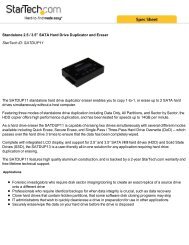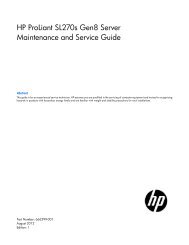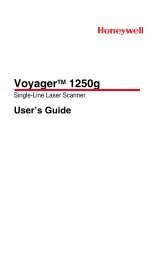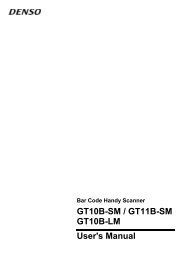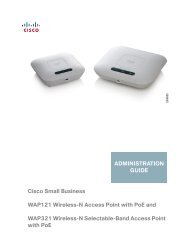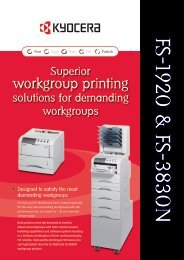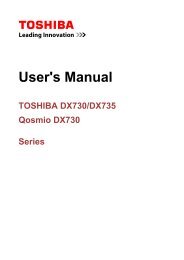User Manual - Etilize
User Manual - Etilize
User Manual - Etilize
Create successful ePaper yourself
Turn your PDF publications into a flip-book with our unique Google optimized e-Paper software.
Formatting a hard disk drive<br />
Low-level formatting removes all data from the hard disk. If there is data on the disk<br />
that you want to save, back up the hard disk before you perform this procedure.<br />
Note: Before you format a hard disk, make sure that the disk is not part of a<br />
mirrored pair.<br />
To format a drive, complete the following steps:<br />
1. From the list of adapters, select the controller (channel) for the drive that you<br />
want to format and press Enter.<br />
2. Select SAS Topology and press Enter.<br />
3. Select Direct Attach Devices and press Enter.<br />
4. To highlight the drive that you want to format, use the Up Arrow and Down<br />
Arrow keys. To scroll left and right, use the Left Arrow and Right Arrow keys or<br />
the End key. Press Alt+D.<br />
5. To start the low-level formatting operation, select Format and press Enter.<br />
Creating a RAID array of hard disk drives<br />
To create a RAID array of hard disk drives, complete the following steps:<br />
1. From the list of adapters, select the controller (channel) for the drives that you<br />
want to mirror.<br />
2. Select RAID Properties.<br />
3. Select the type of array that you want to create.<br />
4. Use the arrow keys to highlight the first drive in the pair; then, press the Minus<br />
(-) or Plus (+) key to change the mirror value to Primary.<br />
5. Continue to select the next drive using the Minus (-) or Plus (+) key until you<br />
have selected all the drives for your array.<br />
6. Press C to create the disk array.<br />
7. Select Apply changes and exit menu to create the array.<br />
IBM Advanced Settings Utility program<br />
The IBM Advanced Settings Utility (ASU) program is an alternative to the Setup<br />
utility for modifying UEFI settings. Use the ASU program online or out of band to<br />
modify UEFI settings from the command line without the need to restart the system<br />
to access the Setup utility.<br />
You can also use the ASU program to configure the optional remote presence<br />
features or other IMM settings. The remote presence features provide enhanced<br />
systems-management capabilities.<br />
In addition, the ASU program provides limited settings for configuring the IPMI<br />
function in the IMM through the command-line interface.<br />
Use the command-line interface to issue setup commands. You can save any of the<br />
settings as a file and run the file as a script. The ASU program supports scripting<br />
environments through a batch-processing mode.<br />
For more information and to download the ASU program, go to<br />
http://www.ibm.com/systems/support/.<br />
Chapter 3. Configuring the server 83




